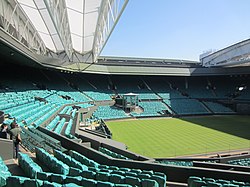Centre Court

Centre Court at Wimbledon, 2012
|
|
| Location |
All England Lawn Tennis and Croquet Club Wimbledon, London, SW19 |
|---|---|
| Public transit |
|
| Owner | AELTC |
| Capacity | 15,916 seats |
| Surface | Grass |
| Construction | |
| Opened | 1922 |
| Renovated | 2009 |
| Construction cost |
£100 million (2009 renovation) |
| Architect |
Populous (formerly HOK Sport) (2009 renovation) |
| Tenants | |
|
Summer Olympics (2012) |
|
Centre Court is the main court at the Wimbledon Championship, the third annual Grand Slam event of the tennis calendar. It is considered the world's most famous tennis court. It incorporates the clubhouse of the All England Lawn Tennis and Croquet Club. Its only regular use for play is during the two weeks a year that the Championships take place. Centre Court has a premier box, known as the Royal Box, for use by the Royal Family and other distinguished guests.
A retractable roof was installed in 2009, enabling play to continue during rain and into the night up until a council-imposed curfew of 11 pm. Centre Court, along with No. 1 Court and No. 2 Court, was also host to the tennis competition at the 2012 Summer Olympics.
The name "Centre Court" derives from the location of the principal court at the All England Croquet Club's original site off Worple Road, Wimbledon – where the main court was located in the centre of all the other courts. For the first Wimbledon Championship in 1877 a total of 12 courts were available which were laid out in a 3×4 grid and there was no actual centre court. This changed in 1881 when the middle two courts of the middle row were combined to form a Centre Court. The name was kept when the club relocated to its present site at Church Road in 1922. It was not until a further four courts were added in 1980 that Centre Court's location in the grounds again matched its name.
The initial capacity of the Centre Court is not known. In 1881 temporary covered stands (A, B and C) were erected on three sides of the Centre Court and in 1884 stand A was converted into a permanent stand, to be followed in 1885 by the conversion of stands B and C. In 1886 the three stands were joined at the corners to form a continuous structure. The stands were considerably enlarged in 1906 and in 1909 a new stand B was constructed increasing capacity by 600 seats. In 1914 the seating capacity was increased from 2,300 to 3,500 and this remained unchanged until the move to the new ground at Church Road.
...
Wikipedia
